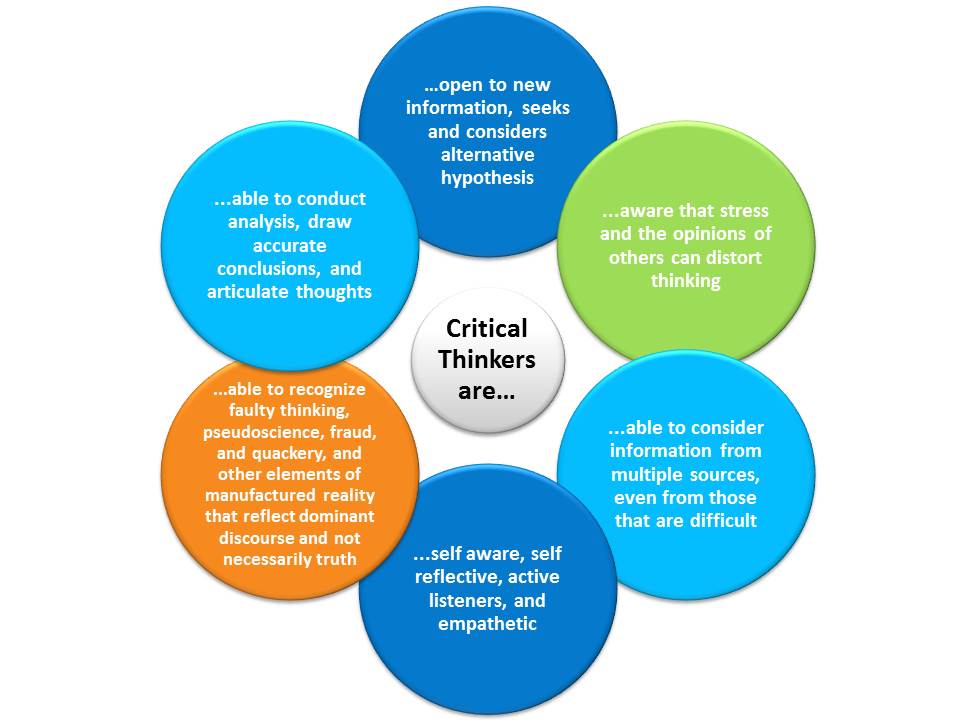Critical Thinking & EIP
Critical thinking describes the process that we use to make decisions about important events and issues in our daily work and personal lives (PART, 2012). When reviewing research evidence, contextual factors, child and family preferences, and incorporating practitioner wisdom, it is vital to use a critical thinking lens, questioning and continually reflecting on the decisions and judgements that we make.
Critical thinking is...
- The art of analyzing and evaluating our thinking with a view to developing a deliberate process
- Guided by careful examination of beliefs and perspectives
- Self-directed, self-disciplines, self-monitored, and self-corrective
- A journey which will be experienced differently by everyone (PART, 2012; Paul & Elder, 2006).
Critical thinkers are...

Sample critical thinking questions:
- What question or problem am I trying to answer?
- From what point of view or perspective am I thinking?
- What information am I using to base my decision upon?
- Have I sought information from multiple sources or points of view?
- What are the alternative points of view?
- How am I interpreting this information?
- Am I drawing inferences that are logical and follow from the evidence?
For more information on critical thinking in child welfare and how it can benefit the children and families you work with, please see our critical thinking guidebook: Taking the Path Less Travelled: Critical Thinking for Child Welfare Practitioners.
What does Evidence-informed Practice look like?
EIP at the Organizational Level
- Implementing evidence-based programs in departments or throughout the organization.
- Using research in policy development.
- At Staff/Department Meetings: Invite staff to discuss research related to a specific issue (e.g., working with high conflict families)that practitioners are facing.
- At Case Conferences: Discuss research in case conferences and decision-making.
- At Team Meetings: Support teams to develop their own strategies for utilizing evidence.
EIP at the Individual Level
- Ensuring that you incorporate research into decisions.
- Supervision: Devote time during supervision to discussing the evidence as it pertains to a certain topic or pending case decision (e.g., what are some evidence-based interventions for caregivers with substance misuse issues and what community organizations offer this intervention).
- Professional Development: Individuals identify their own EIP learning needs (e.g., goal to become knowledgeable about strategies to engage families who have worked with child welfare over multiple generations).
- Reminders: Individual practitioners should develop and set their own reminders to explore research (e.g., every Friday afternoon for half an hour search the research on a specific case problem).
What should I consider when interpreting research evidence?
- What methodology was used in this study?
- What are the limitations and strengths of this type of methodology?
- What are the key characteristics of the population involved in the study?
- Are there similarities and/or differences between this population and the children and families I am working with?
- How might this impact the relevance and applicability of this research to my practice?
- Where was this research carried out? E.g. in a rural/urban setting? In Canada, Europe, Australia?
- Are issues of culture and ethnicity considered in this research?
- What do the results indicate?
- What do these statistics really mean?
- Can I apply these findings to my practice? What do I need to consider before doing so?
- What do these results mean to me and my work with children and families?
- Are these results generalizable?
- If not, how might they inform my practice?
- What does previous literature say about this issue?
References
- Collins-Camargo, C. & Royse, D. (2010). A study of relationships among effective supervision, organizational culture promoting evidence-based practice, and worker self-efficacy in public child welfare. Journal of Public Child Welfare, 4, 1-24.
- Epstein, I. (2009). Promoting harmony where there is commonly conflict: Evidence-informed practice as an integrative strategy. Social Work in Health Care, 48, 216-231.
- Gambrill, E. (1999). Evidence-based practice: An alternative to authority-based practice. Families in Society: The Journal of Contemporary Human Services. 80, 341-350.
- Gambrill, E. (2001). Social work: An authority-based profession. Research on Social Work Practice. 11, 166-176.
- Gambrill, E. (2008). Evidence-based (informed) macro practice: Process and Philosophy. Journal of Evidence-Based Social Work, 5, 423-452.
- Nevo, I., & Slonim-Nevo, V. (2011). The myth of evidence-based practice: Towards evidence-informed practice. British Journal of Social Work, 41, 1176-1197.
- Paul, R. & Elder, L. (2006) Critical Thinking: Learn the Tools the Best Thinkers Use. Columbia Ohio: Person Prentice Hall.
- Practice and Research Together (PART, 2012). Taking the Path Less Travelled: Critical Thinking for Child Welfare Practitioners.
- Trocmé, N., Esposito, T., Laurendeau, C., Thomson, W., & Milne, L. (2009). Knowledge mobilization in child welfare. Criminologie, 42, 33-59.
